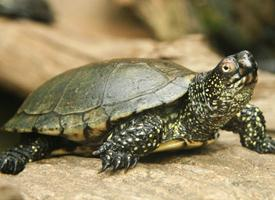
Súlyok és méretek
| Hossz | 15-tól 25-ig cm |
|---|
Állatleírás
The European pond turtle (Emys orbicularis), also known as the European pond terrapin, is a fascinating and ancient species of turtle native to a wide range of habitats across Europe and parts of Asia and North Africa. This semi-aquatic reptile is distinguished by its distinctive physical features and behaviors, making it a subject of interest for both researchers and wildlife enthusiasts.Physical Characteristics:
The European pond turtle possesses a sturdy, dark-colored carapace (shell) that can vary in hue from black to olive green, often adorned with yellowish or whitish spots or streaks, which serve as camouflage among the aquatic vegetation. The carapace is typically oval-shaped and slightly domed, measuring about 12 to 38 centimeters in length, with males generally being smaller than females. The plastron (the underside of the shell) is usually lighter, featuring similar speckled patterns. Its head, legs, and tail are covered with soft skin, exhibiting similar coloration to the shell with patches of yellow or white, especially around the neck and leg areas.
Habitat and Distribution:
Emys orbicularis is remarkably adaptable, inhabiting a variety of freshwater environments such as ponds, lakes, marshes, rivers, and streams. These turtles prefer areas with abundant vegetation, both submerged and floating, which provide them with food, shelter, and basking spots. The European pond turtle has a broad distribution, ranging from Western Europe and North Africa to the Caucasus and parts of Central Asia, though its populations are often fragmented and vary significantly in size across its range.
Behavior and Diet:
European pond turtles are diurnal, spending much of their day foraging for food and basking in the sun on logs, rocks, or riverbanks to regulate their body temperature. They are excellent swimmers and tend to be quite agile in the water. Their diet is omnivorous, consisting of a variety of aquatic plants, insects, mollusks, small fish, and amphibians. Juveniles tend to have a more carnivorous diet, which gradually becomes more herbivorous as they mature.
Reproduction:
The mating season for European pond turtles typically occurs in spring, after which females lay their eggs on land, choosing sandy or loamy soil near water bodies to construct their nests. A female can lay between 2 to 15 eggs, which she covers with soil to incubate. The incubation period varies, usually lasting between two to three months, and is temperature-dependent, with warmer temperatures favoring the development of females. Hatchlings are entirely independent from birth and must find their way to water while avoiding numerous predators.
Conservation Status:
The European pond turtle is considered vulnerable in certain parts of its range due to habitat loss, pollution, invasive species, and collection for the pet trade. Conservation efforts are in place in various countries to protect and restore its habitats, as well as to mitigate other threats. These include establishing protected areas, breeding programs, and public education campaigns to raise awareness about the species and its ecological significance.
In conclusion, the European pond turtle is a resilient and intriguing species with a long evolutionary history. Its presence is indicative of healthy, unpolluted water ecosystems, making it an important species for biodiversity and environmental conservation efforts.
Előfordulási térkép

Hasonló állatok
Új állatfotók
Top 10 állat
- Dolphin gull (Leucophaeus scoresbii)
- Diana monkey (Cercopithecus diana)
- Moustached guenon (Cercopithecus cephus)
- Galápagos tortoise (Geochelone nigra complex)
- Japanese macaque (Macaca fuscata)
- Russian tortoise (Testudo horsfieldii)
- Stone loach (Barbatula barbatula)
- Greek tortoise (Testudo graeca)
- Common flying dragon (Draco volans)
- Vendace (Coregonus albula)

